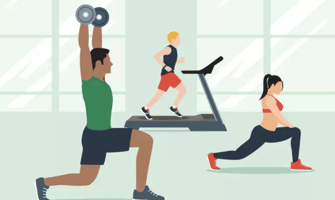Discover the ideal exercise duration for maximum benefits and avoid potential risks.
Top Exercises for Sciatica Pain Relief
Discover effective exercises to alleviate sciatica pain and improve your quality of life.
The Root Causes of Sciatic Nerve Pain
Sciatic nerve pain, also known as sciatica, is often caused by a herniated disc in the lower back. When the disc presses against the nerve roots that form the sciatic nerve, it can result in pain, numbness, and tingling that radiates down the leg.
Other common causes of sciatic nerve pain include spinal stenosis, which is the narrowing of the spinal canal, and piriformis syndrome, which occurs when the piriformis muscle in the buttocks irritates the sciatic nerve.
Understanding the root causes of sciatic nerve pain is crucial for effective treatment and pain relief.
Benefits of Exercise for Sciatica Pain Relief
Exercise plays a vital role in relieving sciatica pain and improving overall quality of life. Regular exercise helps to strengthen the muscles that support the spine and improve flexibility, reducing the risk of further injury and helping to alleviate pain.
Exercise also promotes the release of endorphins, which are natural painkillers produced by the body. These endorphins can help to reduce pain sensitivity and improve mood.
In addition, exercise can aid in weight management, as excess weight can put additional strain on the spine and worsen sciatica symptoms.
By incorporating exercise into your daily routine, you can experience significant relief from sciatica pain and enhance your overall well-being.
Top Exercises for Sciatica Pain Relief
1. Hamstring Stretches: Lie on your back and bend one knee, keeping the other leg straight. Slowly raise the straight leg towards the ceiling until you feel a gentle stretch in the back of your thigh. Hold for 30 seconds and then switch legs. Repeat 3 times on each side.
2. Piriformis Stretch: Sit on a chair or bench with your feet flat on the floor. Cross one ankle over the opposite knee, then gently lean forward until you feel a stretch in your buttocks. Hold for 30 seconds and then switch sides. Repeat 3 times on each side.
3. Bird Dog Exercise: Start on your hands and knees, with your hands directly under your shoulders and your knees under your hips. Extend one arm forward and the opposite leg back, keeping your core engaged. Hold for 5 seconds, then switch sides. Repeat 10 times on each side.
4. Cat-Camel Stretch: Get on your hands and knees, with your hands directly under your shoulders and your knees under your hips. Arch your back towards the ceiling, tucking your chin into your chest. Hold for a few seconds, then lower your back and lift your head, looking up towards the ceiling. Repeat 10 times.
5. Pelvic Tilt Exercise: Lie on your back with your knees bent and your feet flat on the floor. Slowly tilt your pelvis towards your belly button, flattening your lower back against the floor. Hold for a few seconds, then release. Repeat 10 times.
These exercises can help to stretch and strengthen the muscles that support the spine, alleviate pressure on the sciatic nerve, and reduce pain and discomfort. It is important to perform these exercises correctly and listen to your body. If any exercise causes increased pain or discomfort, stop immediately and consult a healthcare professional.
Tips for Incorporating Exercise into Your Routine
Incorporating exercise into your daily routine can be challenging, but with a few tips, it can become a manageable and enjoyable part of your day:
- Start slowly: If you're new to exercise or have been inactive for a while, start with gentle exercises and gradually increase the intensity and duration over time.
- Find activities you enjoy: Choose exercises that you find enjoyable, whether it's walking, swimming, yoga, or dancing. This will make it easier to stick to your routine.
- Schedule regular exercise: Set aside specific times in your day for exercise and treat them as non-negotiable appointments with yourself. Consistency is key.
- Listen to your body: Pay attention to how your body feels during and after exercise. If you experience pain or discomfort, modify the exercise or consult a healthcare professional.
By following these tips, you can successfully incorporate exercise into your routine and experience the benefits of sciatica pain relief.
Consulting a Healthcare Professional for Sciatica Management
While exercise can be highly effective in relieving sciatica pain, it's important to consult a healthcare professional for proper diagnosis and guidance. They can help determine the underlying cause of your sciatica and recommend appropriate exercises and treatments tailored to your specific condition.
A healthcare professional can also provide valuable advice on posture, ergonomics, and lifestyle modifications that can further alleviate sciatica pain and prevent future episodes.
Remember, every individual is unique, and what works for one person may not work for another. Seeking professional guidance ensures that you receive personalized care and maximize your chances of finding long-lasting pain relief.






